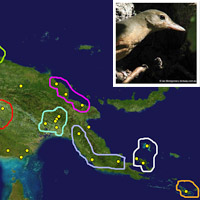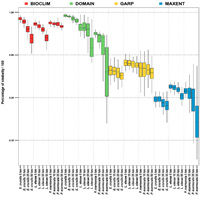
Predictive Distribution Modeling
 Back to Home
Back to Home
Intro text here: Anchors to each section
New Guinea Birds
 |
An integrative approach to the phylogeography of lowland New Guinea birds: combining data from museum collections, genetics, and predictive distribution models
New Guinea is the world’s largest tropical island, boasting vast tracts of lowland forest and rich faunal assemblages. Many lowland bird species are commonly “lumped” into a single species because their habitat is continuous and assumed to be homogeneous. Emerging phylogeographic research by Dr. Jack Dumbacher, Chairman and Assistant Curator of the Department of Ornithology and Mammalogy at the Academy and Kristy Deiner, Ph.D. student in the Ecology Graduate Group at UC Davis has identified previously unrecognized diversity among New Guinea lowland birds.
CBRI partnered with Dr. Dumbacher and Deiner to test their genetic hypothesis for The Little Shrike-Thrush (Colluricincla megarhyncha) using georeferenced museum collection localities, GIS, and predicted distribution modeling software. Our ecological niche models help reinforce their phylogenetic hypotheses of taxonomic differentiation within large continuous basins. By combining these research tools; taxonomy, niche modeling, and geographic barriers, we can begin to efficiently identify conservation priority areas in New Guinea.
|
Downloads
|
Locality Accuracy and Predictive Distribution Modeling
 |
Assessing the effects of locality accuracy in predicting species distributions (find updated title)
Description and links
People and Institutions
Conservation Impacts |
Downloads
|
Smithsonian Project
 |
Description and links
People and Institutions (CBRI, John Dumbacher, Kristy Deiner)
Conservation Impacts |
Downloads
|

